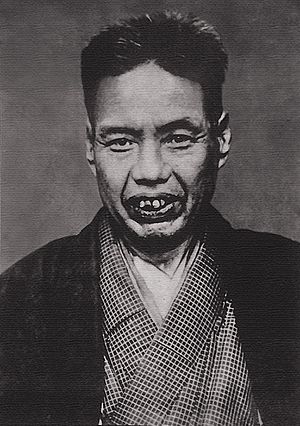Kawanabe Kyōsai facts for kids
Quick facts for kids
Kawanabe Kyōsai
|
|
|---|---|
| 河鍋 暁斎 | |

Kanawabe Kyōsai in 1880s.
|
|
| Born |
Kawanabe Kyosai
18 May 1831 Koga Ishimachi, Shimousa Province, (currently Koga City, Ibaraki Prefecture), Japan
|
| Died | 26 April 1889 (aged 57) Zuirinji Temple, Tokyo, Japan
|
| Resting place | Taitō Ward, Tokyo |
| Nationality | Japanese |
| Education | Utagawa Kuniyoshi, Kanō Eitoku |
| Known for | Painting, drawing, portraits |
| Movement | Ukiyo-e, Japanese Zen, Nihonga |
Kawanabe Kyōsai (河鍋 暁斎, May 18, 1831 – April 26, 1889) was a famous Japanese artist. A critic once called him "an individualist and an independent." They also said he was perhaps the last great artist in traditional Japanese painting.
Contents
A Life in Art: Kawanabe Kyōsai
Kyōsai lived during a big change in Japan. He saw the country go from the old Edo period to the new Meiji period. Japan changed from a land ruled by powerful lords to a modern nation.
Early Life and Training
Kyōsai was born in Koga. His father was a samurai, a Japanese warrior. As a young boy, Kyōsai worked for a short time with the artist Utagawa Kuniyoshi. Later, he trained in the Kanō school of art. His teacher, Maemura Tōwa, even gave him the nickname "The Painting Demon." But Kyōsai soon left the strict rules of this school. He preferred the freedom of more popular art styles.
Art and Political Change
Kyōsai became known for his funny drawings, called caricatures. These drawings often made fun of important people or events. He lived during a time of big political excitement. This was before and after the Meiji Restoration in 1867. This event brought the Emperor back to power.
Kyōsai's art often showed his strong opinions. He was even arrested a few times by the government for his drawings. After the Emperor took power, a big meeting of artists and writers happened. Kyōsai was there. He drew another caricature that became very popular. But it also got him into trouble with the new police!
Kyōsai's Unique Style
Many people think Kyōsai was the greatest artist to follow Katsushika Hokusai. Hokusai was another very famous Japanese artist. Kyōsai's art was wild and full of energy, just like his life. He was a very skilled artist. His drawings were always interesting because of his amazing talent.
The First Manga Magazine
In 1874, Kyōsai helped create what many consider the first manga magazine. It was called Eshinbun Nipponchi. He worked with a writer named Kanagaki Robun. This magazine was inspired by Japan Punch, a British cartoon magazine. Eshinbun Nipponchi had simple drawings. It only lasted for three issues, so it wasn't very popular.
Other Famous Works
Besides his caricatures, Kyōsai painted many other pictures and sketches. He often drew subjects from Japanese stories and traditions. He also painted scenes from Noh theater, nature, and religion. For example, he painted The Temptation of Shaka Niorai and The goddess Kwannon on a dragon.
You can find many of his works in the British Museum in London. There are also good examples in the National Art Library in South Kensington and the Guimet Museum in Paris. In Japan, the Kawanabe Kyōsai Memorial Museum opened in 1977. It is in Warabi, Saitama Prefecture.
A Legacy in Space
Kyōsai's fame even reaches space! A crater on the planet Mercury has been named in his honor.
Images for kids
-
Renjishi (Dance of a Pair of Lions), by Kyōsai. This is a famous dance from Kabuki theater.
See also
 In Spanish: Kawanabe Kyōsai para niños
In Spanish: Kawanabe Kyōsai para niños




